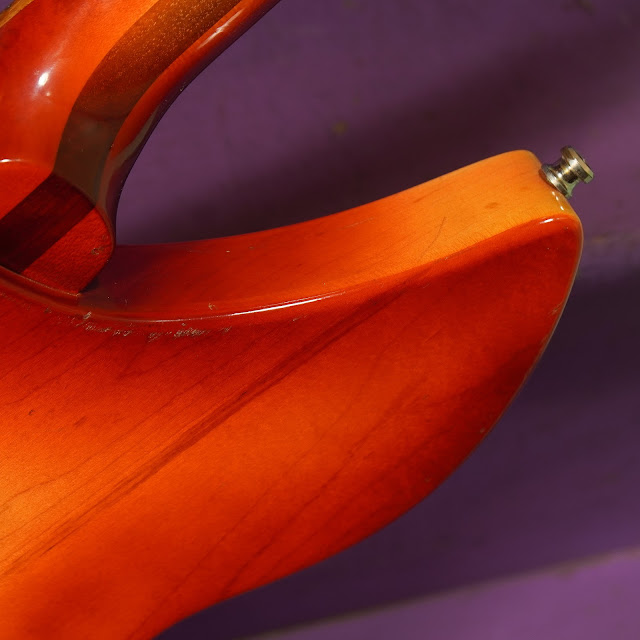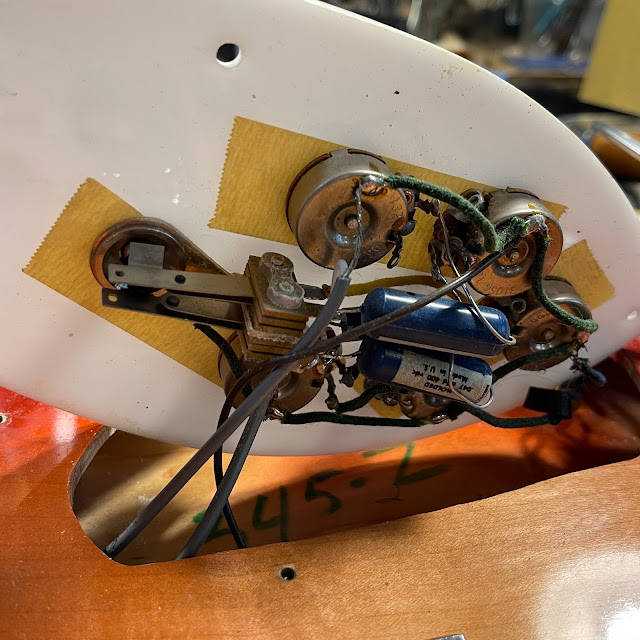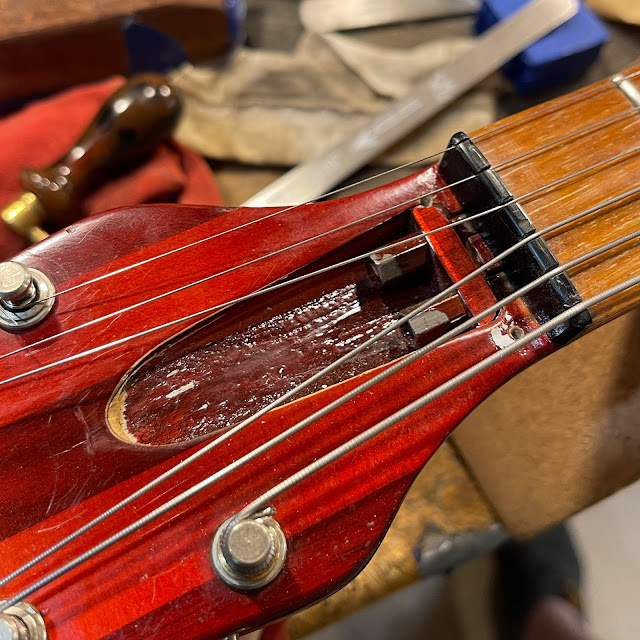1966 Rickenbacker 335 Semihollow Electric Guitar
This guitar is a beaut and a treasure right out of the gate. It's clean, sounds like a million bucks, handles ridiculously fast, and looks stunning. How could you not like it? I may have a bit of a thing for Ricks, though, and it doesn't get much more '60s flashy-iconic than these models, made famous by all those famous folks who used them and who used them for good reason...
It came to the shop mostly in decent order, though the setup was quite a mess and it needed a small little crack near the nut at the neck's side clamped-up. Post-repairs it's playing spot-on. Said neck is slim, quick, has a good tight radius to it, and is everything I like when I'm playing rhythm guitar -- fast!
While setting it up and adjusting it, I did a small wiring mod to get better tone out of the bridge pickup. The "factory" wiring rolls a lot of bass out of the bridge pickup's signal and it's very easy to bypass this by wiring in the form of adding a small jumper (easily removed in case the next owner wants to have it out). I put that jumper in and straightaway the guitar began behaving itself in the middle position and the bridge position became useful rather than just a smear of high-end. That smear does sound great, though, in its own way -- so keep in mind that this is easy-peasy to reverse.
I also added some foam support for the bridge pickup so its height can be dialed-in more effectively. This let me get it cranked a little closer to the strings so its volume is balanced with the neck pickup.
After tweaking the strings a bit and getting them stretched-out and the roller saddles lubed, the Vibrola-style tailpiece whammy is working quite well. I play it towards the end of the demo video to give an idea of its sound.
Of interest is that it was stamped "345" in the control cavity, suggesting that it was meant to have 3 pickups instead.
Repairs included: a fret level/dress, minor wiring adjustment, minor crack repair, and setup work.
- Weight: 7 lbs 7 oz
- Scale length: 24 3/4"
- Nut width: 1 9/16"
- Neck shape: slim-medium C
- Board radius: 7 1/4"
- Neck depth at 1st fret: 27/32"
- Neck depth at 7th fret: 55/64"
- Body width: 14 3/4"
- Body depth: 1 1/2"
- Body wood: maple
- Bridge: 6-saddle adjustable with rollers
- Fretboard: rosewood
- Neck wood: multi-piece maple/mahogany
- Pickups: 2x original toaster single coils
- Action height at 12th fret: 1/16” overall (fast, spot-on)
- String gauges: 50w, 38w, 28w, 22w, 15, 11 flatwounds at the moment (plain G in pics)
- Truss rod: adjustable
- Neck relief: straight
- Fret style: medium
Condition notes: This guitar is clean for its age with wear confined to a little bit of topcoat rub-off on the back of the neck and some nicking/scratching mostly at the rear edges of the instrument. There's minor finish weather-checking here and there, too, but mostly it just glows. I mean, it is fireglo afterall! It has a very small, 1" thin (1/8"-deep) hairline crack that's repaired at the bass side of the nut on the neck. I've taken a photo of it. The strap buttons are unoriginal and so are the repro knobs and some of the original hardware (bridge cover, grommets, all original knobs) are stowed safely in the case. The wiring harness was completely original as-found but I've wired a single jumper to bypass the bass roll-off for the bridge pickup which is hardwired on these. This allows the player to hear the "true blue" sound of the guitar's pickups and is more functional. The 5th knob (neck volume roll-off when in "middle" position) works as it should. Final note? This guitar tends to like slightly heavier gauges and it's currently strung-up with flatwound 11s.
It comes with: It has its original hard case, bridge cover, knobs, and other minor bits.


































Comments